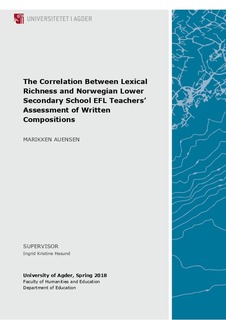| dc.description.abstract | This master thesis investigates Norwegian lower secondary EFL teachers’assessment of their students’written compositions. It focusses on the vocabulary skills these students displayandaims to reveal whether the level of vocabulary each student reveals is consistent with the grade their texts receivefrom their teachers.Words are thebuilding blocks of our language (Read, 2000, p.1), one would not get fartrying to communicate in a language without knowing its words.Analysing a texts lexical richness is a way of measuring the vocabulary level of the text.A text’s lexical richness describes how developed the vocabularyofthe text is(Cobb & Horst, 2015, p. 189). Three components of lexical richness, namely lexical sophistication, lexical diversity and lexical density,were measuredin order to analyse thestudent texts.Previous research on this field has found correlations between students’lexicalrichness and the holistic quality of the composition(e.g Laufer & Nation, 1995; Roessingh, Elgie &Kover, 2015; Crossley, Salsbury, McNamara, and Jarvis, 2012). This thesis wishes to explore whether such correlations are found in the Norwegian lower secondary school as well.27 excerpts of Norwegian 9thgraders mock examswere analysed byrunning them through Cobb’s (2019) Vocabprofile(VP Compleat, v.2), a lexical profilingprogrambased on Laufer and Nation’s(1995)RANGE. The texts had been graded by their teachers and divided into two groups; intermediate (grade 3-4) andhigh-level (grade 5-6). The texts’type-token ratioandlemma-token ratio, the number of advanced words, and thelexical density were found for each 300-word excerpt. These measurements represented, respectively, the lexical diversity, sophistication and density ofthe texts.A statistical analysis was then conducted to compare these components to the grade level of each text. The analyses revealed that there wasa significant difference between the two groups’lexical sophistication and diversity, though not inlexical density. Positive correlations were also found between the lexical sophistication and diversity of the two groups,while there was no correlation between grade level and lexical density score. Three student texts were chosen for a brief qualitative analysisbased on their lexical richness scores.Two of these students receivedthe same grade, despite a large difference in lexical richness score. It was, therefore, concluded that students with a good vocabulary seem to receivehigher grades on their written production, though not without exceptions. The brief qualitative analysis revealed that other factors, not surprisingly,have a part in deciding the grade as well as vocabulary. It is suggested thatteachers are consciousof how they assess student texts, as theseresultsalongside previous research haveshown that a good vocabulary may affect their judgement of other linguistic features. | nb_NO |

